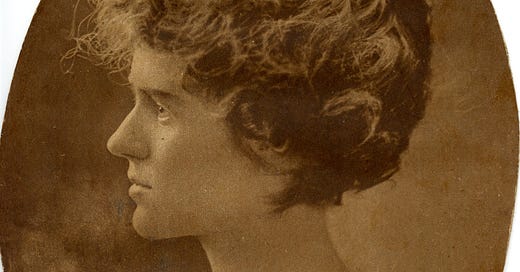Marion Davis Audio-Tape Transcriptions
Sometime before her death in 1986, Marion Davis recorded her memories at the encouragement of her brother, Walter Buck. The recordings were transcribed by a secretary.
The Friends of Wapack have made these available to the Historical Society. Marion was born on February 8, 1894 in Fitchburg, MA.
Cutting Firewood (Water Power)
It took a lot of wood to keep that house warm. We burned wood in the kitchen stove, and they did have a furnace in the cellar--the wood had to be cut up 16" long for that. It was an everlasting job--took a lot of it. We did most of that down in the north lot; there were a lot of beech trees down there, we cut them out from the timber that was growing. Frank used to say that the timber down in the north lot was his life insurance. We thought of raising corn, millet, Hungarian stuff for the cattle. Quite a brook of water ran thru the valley toward Hubbard Pond. Frank had dammed up the upper side where the road went town to the Woodard place and used to cut ice. there and put it into an ice house. They'd cover it with sawdust to keep it. Then over in what was called the Old Cowpasture he built another dam he built a mill, where he sawed out when he was a young man (the first thing he ever did). We saw out pail staves for pails and small tubs with circular saws. I never happened to see that done; that was before I went to the farm to live, but I used to see those saws and wonder how anyone in the world could saw anything with that. I saw some of the staves that had been left there. That is how he cut the lumber for his house after the fire had destroyed it. Then too there was quite a cellar underneath, and the way he got his power was from the dam he had built what they called a "Shaft" [?]. You could open this shoot and the water would run down onto this wheel. It was an upright shaft, and the water would go into cups and that would start that shaft going around, and that gave him his power. We used to back the big wagon in under the mill there and where he had a cutting- off saw we could run our wood in on a carriage we could saw wood and it would drop right down thru a shoot and into the wagon.
I remember one winter we had a whole lot of wood down in there packed in pretty full but there came so much snow with a heavy crust that we couldn't get down there to get it. Oh, I think the snow was 3' deep and in places on the road it had drifted so that it was deeper than that even. For the furnace we'd go down side the road, Cut a tree down, hitch a horse on and drag it up. For a little while we had to do it that way. Course that didn't last long before the snow went
down.
Photo Archives
Photo of a young woman from the Society Archives, unidentified and undated
James Roger diary entry
4th December 1912
Frosty, fair, and mild; wind variable from East to West. David went for coal for Mrs. Tucker in forenoon and took Tom to Chandlers’ in the afternoon. I stopped in house all day except feeding hens and taking litter from barn to henhouse. Also lit church fire for Sewing Circle tomorrow. Had cow out all day. Got letter from Hamish.




I think Marion means a “chute” in describing the milling operations rather than a “shoot.” They all worked very hard in those days just to heat a building and eat all homemade food. Explains why she had zero tolerance for kids goofing around, and what she perceived as their goofing around, in the post-war years when she was a school cook and I was enrolled at Central School. She knew how difficult and dangerous it had been for ordinary folks to make a living.
I remember my grandfather's sawmill powered by a Model A. I think earlier it had a Model T. There was a small stream and pond but not suitable for a waterwheel. I remember filling the woodshed and the woodbin in the kitchen. I don't recall a furnace, actually never went into the basement, nor did I witness my grandfather ever going there.